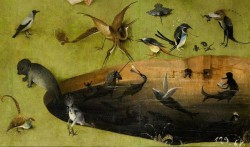
Lurker 1967b
“Das Tier in der Bildwelt des Hieronymus Bosch” (Manfred Lurker) 1967
[in: Studium Generale, 20 (1967), pp. 212-220]
[Also mentioned in Gibson 1983: 59 (D77)]
In order to understand Bosch’s art it is necessary to become familiar with the late-medieval way of thinking, the roots of which can be partially traced back to Germanic and Celtic culture. Important elements of this late-medieval way of thinking are popular belief (animal stories, demonology, the delusion of witchcraft), the official Christian doctrine (Bible, Physiologus, Legenda aurea) and also the esoteric trends (mysticism, heresey, alchemy). Bosch is supposed to have been aware of alchemical symbolism and so, when interpreting the animals in Bosch’s paintings, influence from this source should be taken into account.
After Lurker has pointed out that some animal species in Bosch’s work are often identified in different ways by various authors, he interprets some parts of the Bosch fauna. Easy to explain are those animals that appear as the attribute of a saint (eagle / John the Gospel-writer, lamb / John the Baptist, falcon / St. Bavo, deer / St. Egidius, pig / St. Anthony), the diabolic snake in Eden, the ox and the donkey in the Adoration (see Isaiah 1: 3) and the pelican (a symbol of Christ, already in the Physiologus). Monkey and bear refer to the devil, the same is true for insects. Snakes, toads, frogs and lizards are infernal symbols. A pig can refer to greed or uncleanness. The fish is sometimes a symbol of Christ, sometimes it refers to death. Horse skulls, ravens and magpies are also symbols of death. A deer refers to the human soul, spoonbills and herons refer to life and birth. In Bosch’s paintings the owl is perhaps the keeper of esoteric secrets who knows about the deeper meaning of love and life.
Lurkers interpretations in this article make a superficial, arbitrary and therefore unreliable impression and the author depends a bit too much on what Fraenger and Werheim-Aymès have written about Bosch. The great tits in the Rotterdam Pedlar tondo and in the Ghent St. Hieronymus panel are erroneously identified as woodpeckers.
[explicit]